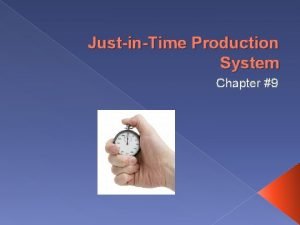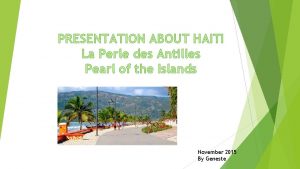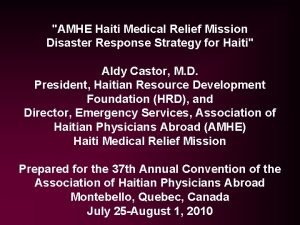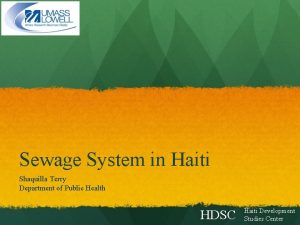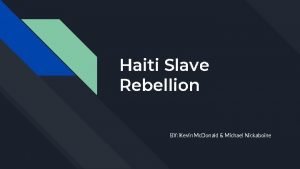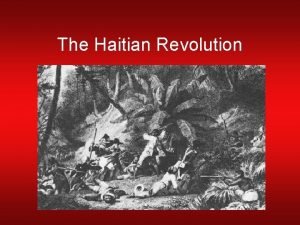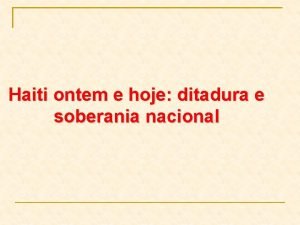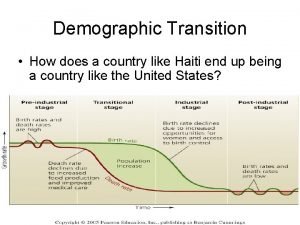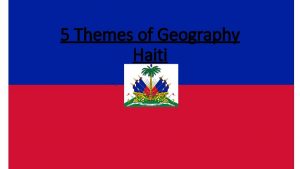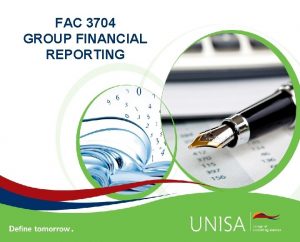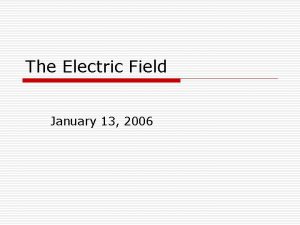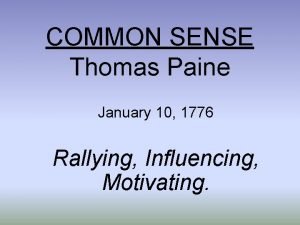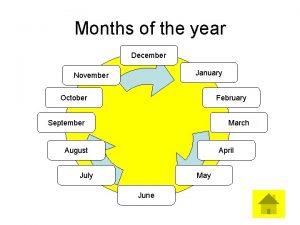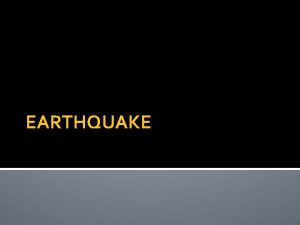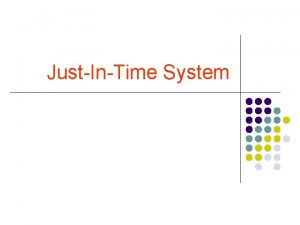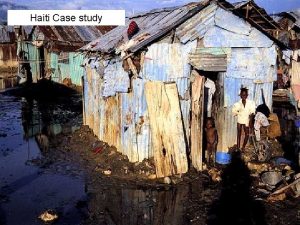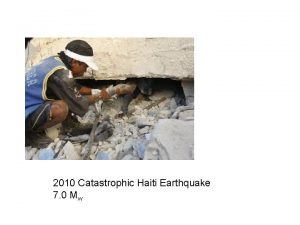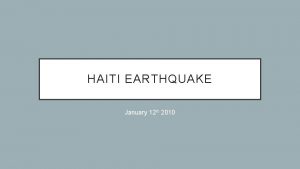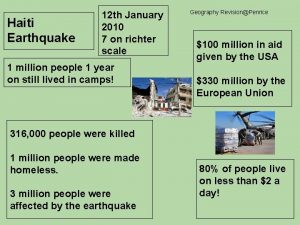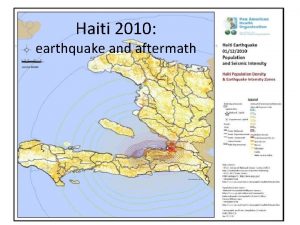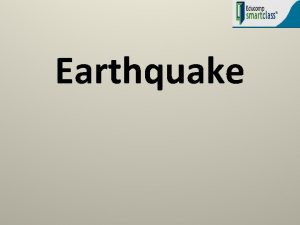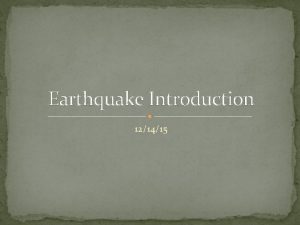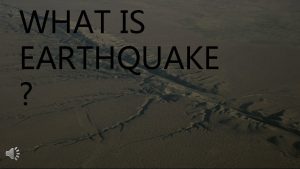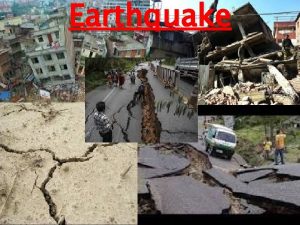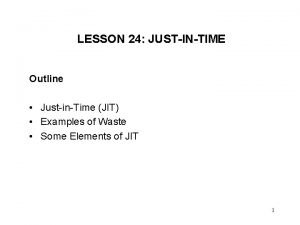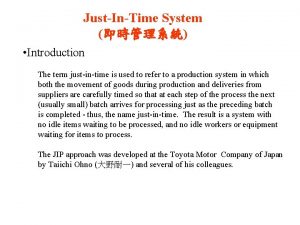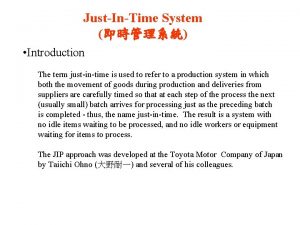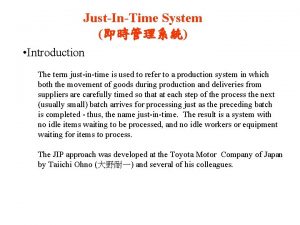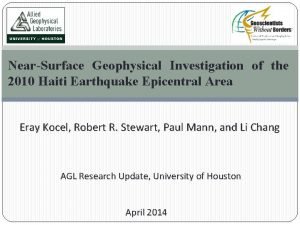JustinTime Lecture Haiti Earthquake January 12 2010 Haitis































- Slides: 31

Just-in-Time Lecture Haiti Earthquake January 12, 2010

Haiti's presidential palace before (top) and after the earthquake Photo: AFP/GETTY

Satellite Photos of Haiti Before and After the Earthquake


What is the Earthquake? The shaking of earth caused by waves moving on and below the earth's surface and causing: surface faulting, tremors vibration, liquefaction, landslides, aftershocks and/or tsunamis.

How Earthquake Happens? § It caused by a sudden slip on a FAULT. § Stresses in the earth's outer layer push sides of fault together. § Stress builds up & rocks slips suddenly, releasing energy in waves that travel through the earth's CRUST & cause the shaking that we Feel during an earthquake.

Earthquake Strength Measures I) Magnitude & II) Intensity I) Magnitude: q Definition: A measure of actual physical energy release at its source as estimated from instrumental observations. q Scale: Richter Scale ü By Charles Richter, 1936 ü Open-ended scale ü The oldest & most widely used Noji 1997

Earthquake Strength Measures I) Magnitude & II) Intensity: q Definition: a measure of the felt or perceived effects of an earthquake rather than the strength of the earthquake itself. q Scale: Modified Mercalli (MM) scale ü 12 -point scale, ranges from barely perceptible earthquakes at MM I to near total destruction at MM XII

Magnitude versus Intensity q Magnitude refers to the force of the earthquake as a whole, while intensity refers to the effects of an earthquake at a particular site. q An earthquake can have just one magnitude, while intensity is usually strongest close to the epicenter & is weaker the farther a site is from the epicenter. q The intensity of an earthquake is more germane to its public health consequences than its magnitude.

Public Health Consequences of Earthquakes Please see the following addresses for above title: Part I. http: //www. pitt. edu/~super 1/lecture/lec 13021/index. htm Part II. http: //www. pitt. edu/~super 1/lecture/lec 13051/index. htm

Just-in-Time Lecture Earthquake in Haiti • Haiti latest and breaking national news and regional news from Haiti • Haiti Earthquake updates • Hôpital Albert Schweitzer Haiti daily notes • Google Crisis response

Just-in-Time Lecture Previous earthquakes on the island • 1751 • 1770 • 1842 • 1946

Just-in-Time Lecture Earthquake Details Magnitude 7. 0 Date-Time • Tuesday, January 12, 2010 at 04: 53: 10 PM at epicenter Location 18. 457°N, 72. 533°W Depth 13 km (8. 1 miles) set by location program Region HAITI REGION Distances 25 km (15 miles) WSW of PORT-AU-PRINCE, Haiti 130 km (80 miles) E of Les Cayes, Haiti 150 km (95 miles) S of Cap-Haitien, Haiti 1125 km (700 miles) SE of Miami, Florida Location Uncertainty horizontal +/- 3. 4 km (2. 1 miles); depth fixed by location program

Just-in-Time Lecture

Just-in-Time Lecture Poverty: Major obstacle to effective disaster mitigation activities • Haiti is one of the poorest countries in the Americas • GDP per capita of 790 USD, about $2 person per day (before the earthquake of 2010) • Ranks 149 th of 182 countries in the United Nations Human Development Index (2006)

Just-in-Time Lecture Public Health Challenges • Large proportion of children unvaccinated • Before the earthquake, only about 40% of the population had access to basic healthcare • High prevalence of waterborne diseases and intestinal parasites (especially in children) • High rates of TB, HIV/AIDs, and malaria • Poor public health infrastructure

Just-in-Time Lecture Public Health Dangers of Haiti Earthquake • Potential breakdowns in sanitation • Difficult access to clean water • Problems with housing and subsequent crowding • Dangers of tropical diseases outbreak • Fragility of existing public health system • Malnutrition

UN: Haiti quake shows need to close technology gap

30 years continuous evolution in the practice of Crisis or Disaster Management § Civil defense § Emergency assistance § Disaster response and relief Strategic shift from managing a disastrous § Humanitarian assistance event to more § Emergency management preventive and § Civil protection § Disaster mitigation and prevention § Disaster Risk Management proactive approaches!!

What is Disaster risk reduction (disaster reduction or DRR)? • The conceptual framework of elements considered with the possibilities to minimize vulnerabilities and disaster risks throughout a society, to avoid (prevention) or to limit (mitigation and preparedness) the adverse impacts of hazards, within the broad context of sustainable development !

What is the Hazard? • A potentially damaging physical event, phenomenon or human activity that may cause the loss of life or injury, property damage, social and economic disruption or environmental degradation. Natural Geological Hyman Induced Earthquake Hydro meteorological Flood, Hurricane Biological Pandemic Environmental degradation Deforestation Technological Nuclear release

What is the Vulnerability? • The conditions determined by physical, social, economic, and environmental factors or processes, which increase the susceptibility of a community to the impact of hazards. • Vulnerable Haiti: o Unprepared people o Non-resistant house & school building o High-density population o etc.

What is Risk? • The probability of harmful consequences, or expected losses (deaths, injuries, property, livelihoods, economic activity disrupted or environment damaged) resulting from interactions between natural or human-induced hazards & vulnerable conditions. • Risk = Hazards x Vulnerability

What is a Disaster ? • A serious disruption of the functioning of a community or a society causing widespread human, material, economic or environmental losses which exceed the ability of the affected community or society to cope using its own resources.

What is a Disaster? • A disaster is a function of the risk process. • It results from the combination of hazards, conditions of vulnerability and insufficient capacity or measures to reduce the potential negative consequences of risk.

Just-in-Time Education Let’s teach the communities right now ! Risk awareness & Knowledge development including education, training, research and information are of the important fields of action for Disaster Risk Reduction!

Information …. § People need information as much as water, food, medicine or shelter. § Information can save lives, livelihoods & resources. § Lack of information can make people victims of disaster. World Disaster Report 2005 – IFRC/RCS

What we should do/do not before, during & after the earthquake? Please read carefully at: http: //earthquake. usgs. gov/faq/prepare. html

List of Supercourse lectures on Earthquakes • Tectonic explanation of the May 12, 2008, Sichuan Earthquake in Chinese China Earthquake: 12 May 2008. Short version in Chinese in Spanish • China Earthquake: 12 May 2008. Long version • Pakistani Earthquake. 8 October 2005 (Spanish version) • Earthquakes 2000 to 2005 From Indonesia to Pakistan • A Case Study for the Setting of Water Supply & Sanitation Priorities in the PAK Emergency • Earthquake & Tsunami South Asia, 26 Dec 2004 • Earthquake Mitigation (in Spanish)

List of other useful Lectures on Disasters at Supercourse • Dead Bodies and Disasters: Principles of Mortuary Services (in Spanish) • Public Health Disaster Consequences of Disasters (In Spanish) (In Russian) (In Arabic) (In Portuguese) (in Japan) • Safety matters: How to Safely Evacuate from your Home • Data for Decision making in disasters: advances and controversies

A Tectonic explanation of the May 12, 2008, Sichuan Earthquake Professor Emeritus Tanya M. Atwater Member, U. S. National Academy of Sciences Dept. Earth Science, 1006 Webb Hall University of California, Santa Barbara, CA 93106 -9630 atwater@geol. ucsb. edu
 Justintime production
Justintime production 01:640:244 lecture notes - lecture 15: plat, idah, farad
01:640:244 lecture notes - lecture 15: plat, idah, farad Haiti amerique international
Haiti amerique international Haiti
Haiti When did yole derose die
When did yole derose die Haiti
Haiti Effluent pumps haiti
Effluent pumps haiti Mc donald haiti
Mc donald haiti Oge haiti
Oge haiti Haitian revolution map
Haitian revolution map Rev cafe haiti
Rev cafe haiti Liste des ophtalmologues d' haïti
Liste des ophtalmologues d' haïti Gerdameria
Gerdameria Haiti dtm stage
Haiti dtm stage Sewage pump size calculator
Sewage pump size calculator Absolute location of haiti
Absolute location of haiti Where is haiti located
Where is haiti located Bailes tipicos de uruguay
Bailes tipicos de uruguay Haiti
Haiti Spih definition
Spih definition Pro-forma entry
Pro-forma entry January 13 2006 calendar
January 13 2006 calendar January 10th 1776
January 10th 1776 25 january 1759
25 january 1759 Mozart who was born on january
Mozart who was born on january January 29 2015
January 29 2015 February and march season
February and march season December november october
December november october Jill kally
Jill kally Syllables in ladybug
Syllables in ladybug January 24, 1848
January 24, 1848 9 months before january 26 2009
9 months before january 26 2009
